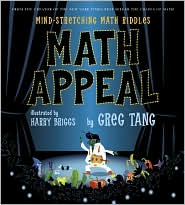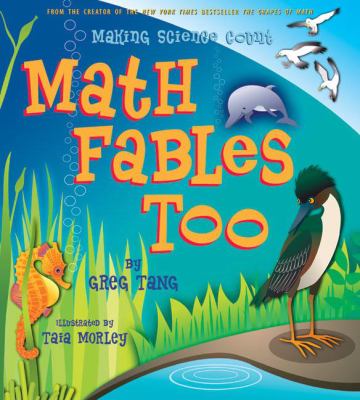Mathematician Greg Tang has partnered with a number of talented illustrators to create highly engaging and entertaining books that use strong visual appeal to help children understand number sense. There is no passive reading here! Tang's books are full of fun word problems, visual games, and poems that help children investigate groupings and patterns. This helps young readers try out different number combination strategies while laying the groundwork for developing addition skills. As Tang writes in his introduction to his book Math Appeal, "I encourage kids to discover different ways of solving each problem and to decide for themselves which approach works best." Letting children explore numerous ways to solve problems allows them to use their own methodology and to try other ways they might not have considered. Tang's humor and use of entertaining, accessible illustrations provide a non-threatening way to encourage students' comfort and proficiency with numbers. His books would be appropriate for elementary grades one through five [for developing number sense with younger students and reinforcing concepts and problem-solving skills with older and/or more advanced students].
Selected Works by Greg Tang
 Math Appeal: Mind-Stretching Math Riddles. By Greg Tang. Illustrated by Harry Briggs. 2003. Scholastic Press (0439210461). Gr. 1 - 5.
Math Appeal: Mind-Stretching Math Riddles. By Greg Tang. Illustrated by Harry Briggs. 2003. Scholastic Press (0439210461). Gr. 1 - 5.
Like Math Potatoes, Math Appeal takes readers on another adventure in problem-solving, inviting them to think "out-of-the-box" (literally and figuratively) and explore the use of patterns and symmetry to find strategic ways to add and subtract. Answers are again in the back, but it would be fun to ask students to write in their math journals to explain how they arrived at their own answers.
Selected Works by Greg Tang
 Math Appeal: Mind-Stretching Math Riddles. By Greg Tang. Illustrated by Harry Briggs. 2003. Scholastic Press (0439210461). Gr. 1 - 5.
Math Appeal: Mind-Stretching Math Riddles. By Greg Tang. Illustrated by Harry Briggs. 2003. Scholastic Press (0439210461). Gr. 1 - 5.Like Math Potatoes, Math Appeal takes readers on another adventure in problem-solving, inviting them to think "out-of-the-box" (literally and figuratively) and explore the use of patterns and symmetry to find strategic ways to add and subtract. Answers are again in the back, but it would be fun to ask students to write in their math journals to explain how they arrived at their own answers.
Math Fables: Lessons That Count. By Greg Tang. Illustrated by Heather Cahoon. 2004. Scholastic Press (0439453992). Gr. K - 1.
This is a delightful book for younger students that makes use of adorable illustrations and lively math poems to help children understand groupings and pre-addition skills. For example, in the poem Tools Gold, there are six hungry sea otters, and Tang helps children see the different number combinations that add up to six. The last two pages of the book have suggestions for activities to help students on "The Road to Higher Math."
 Math Fables Too: Making Science Count. By Greg Tang. Illustrated by Taia Morley. 2007. Scholastic Press (0439783518). Gr. K - 1.
Math Fables Too: Making Science Count. By Greg Tang. Illustrated by Taia Morley. 2007. Scholastic Press (0439783518). Gr. K - 1.
Tang shows children that they are not the only ones using unique problem solving strategies as he uses math and poetry to show how animals use tools to find food. Again, he teaches children how to use number combinations that add up to the numbers one through ten, and the book concludes with fun facts about the animals portrayed in the book.
Math-terpieces: The Art of Problem-Solving. By Greg Tang. Illustrated by Greg Paprocki. 2003. Scholastic Press (0439443881). Gr. K - 2.
Who wouldn't love a clever book that beautifully pairs great works of Western art with colorful math problems? Brilliant! Children can work independently to work out math groupings that are visually suggestive of the works of the masters. The groupings get progressively more challenging, and Tang offers up some hints on how to teach grouping strategies in the back.
Math Potatoes: Mind-Stretching Brain Food. By Greg Tang. Ilustrated by Harry Briggs. 2005. Scholastic Press (0439443903). Gr. 1 - 5.
This book is best suited for older children (ages 7 - 10), but could certainly be used with younger children who are eager for a math challenge and want to take their number sense skills to the next level. Entertaining visual trickery offers up new ways to tackle groupings, find patterns and symmetries, and determine groups of equal size. Tang provides an answer key in the back.
Useful Web Sites
Breaking Numbers Apart: A Lesson with Kindergartners and First and Second Graders by Rusty Bresser and Caren Holtzman
This is a lesson plan from Marilyn Burns's Math Solutions website that asks younger students to "decompose" (break down) numbers less than ten and older students to try the same on larger numbers, in much the same way that Tang's books challenge their readers to do.
Tang's website offers up further instructional guides for teachers to use in their classrooms. A Greg Tang math website is in development, which will provide games and puzzles, among other things. There is a link to his Kakooma math puzzles, as well as Tang's math learning center kits. You can sign up for e-mail updates at this site.
Houghton Mifflin Harcourt provides this all-around go-to source for Greg Tang's Math Street Smarts videos, teacher guides, and interactive games.
While there is not a direct link to the Bayou activities, if you scroll down you will find several links under Big Count Bayou (counting and identifying numbers, addition, grouping objects, addition/subtraction, counting by 2s-5s-10s using 100s charts, grouping and regrouping by 10s and 1s, ordinal numbers, etc.). The colorful graphics and animation are fun and the activities would lend themselves well to a computer work station.
Solving Real-World Problems: A Lesson for First Graders by Chris ConferThis is another great lesson plan from Math Solutions, in which children must figure out how many cookies the teacher will need to bring in to class for each of them for a big cookie party. Children must work out their responses using drawings and writing, and share their problem solving strategies.
Teacher Information
Virginia Standard of Learning
Virginia Standard of Learning
1.1 The student will
a) count from 0 to 100 and write the corresponding numerals; and
b) group a collection of up to 100 objects into tens and ones and write the corresponding numeral to develop an understanding of place value.
Background information from the Curriculum Framework
- Manipulatives are essential to developing the ten-to-one place value concept of our number system and to understanding the value of each digit in a two-digit number. Ten-to-one trading activities with manipulatives on place value mats provide excellent experiences for developing the understanding of the places in the Base-10 system.
- Models that clearly illustrate the relationships among tens and ones are physically proportional (e.g., the tens piece is ten times larger than the ones piece)
- Providing students with opportunities to model two-digit numbers expressed with groups of ones and tens will help students understand the ideas of trading, regrouping, and equality.
- Recording the numeral when using physical and pictorial models leads to an understanding that the position of each digit in a numeral determines the size of the group it represents.




No comments:
Post a Comment